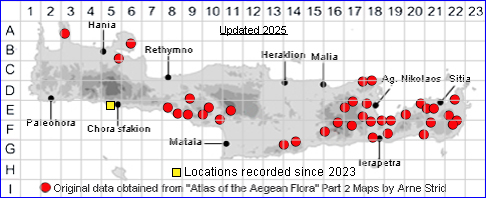
ARISTOLOCHIA CRETICA
Family and Genus:- See- ARISTOLOCHIACEAE
Homotypic Synonyms:- Plagistra cretica.
Meaning:- Aristolochia (Gr) Best-childbirth.
Cretica (L) From Crete.
General description:- Short to medium hairy perennial with erect or spreading
stems, herb, sometimes climbing.
Stems:-
1) 30-60 cm, erect or decumbent, pubescent.
Leaves:-
1) 1-7·5 x 1-8 cm, reniform to deltoid-ovate, about as long as wide.
a) petioles, not more than 5 cm.
Flowers:-
1) Tube, 5-12 cm long, dull purple to brown.
2) Perianth, connate forming the utricle,10-20 mm diam, (resembling a Dutchman's
pipe), with numerous pale bristles in the mouth.
a) Limb, ovate, with basal auricles narrow, emarginate to 2-lobed.
Fruit:-
1) Capsule, 3-6 cm, ovate-oblong.
Key features:-
1) Perianth, with a large conspicuous limb at least 1/5 as long as tube.
2) Perianth-tube, strongly curved, 10-20 mm diam.
3) Utricle, oblong-cylindrical.
4) Leaves, not more than 7·5 x 8 cm.
5) Limb of perianth, ovate, with basal auricles 2-5 mm wide.
Habitat:- Gorges and rocky slopes with dry open shrubby vegetation, often in
semishade by rocks or under bushes, usually on limestone. 0-600(1000) m.
Distribution:- Endemic Crete and Karpathos. Widespread across the eastern part
of Crete with a few scattered occurrences in the central and north west.
Flowering time:- Mid-Mar to end of May.
Photo by:- Steve Lenton
Comments:-
Contrary to common belief this plant is not carnivorous. Insects attracted by its
smell of rotting meat descend into the gaping mouth and down into the bulbous
section, where unable to escape owing to the downward pointing hairs, they
become dusted with pollen. There they remain until the flower begins to die and the
hairs become limp. Released they move onto the next flower and repeat the
process pollinating it in turn.
SPECIES DESCRIPTION
